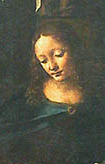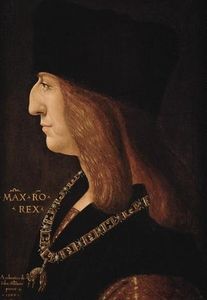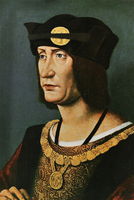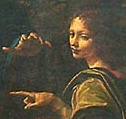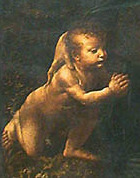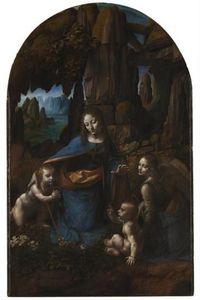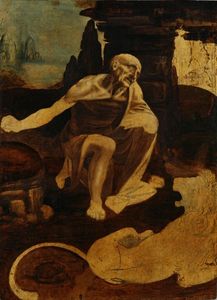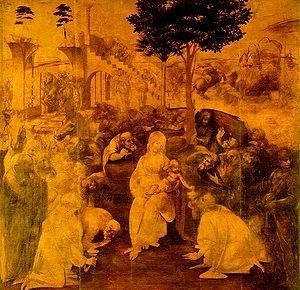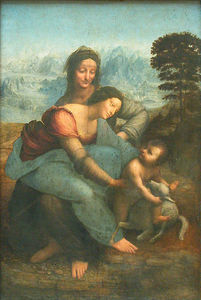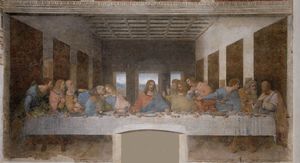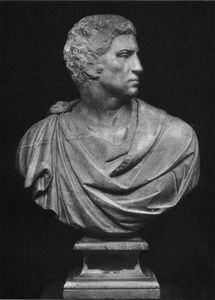The Virgin of the Rocks
- Date of Creation:
- circa 1486
- Height (cm):
- 199.00
- Length (cm):
- 122.00
- Support:
- Canvas
- Subject:
- Figure
- Framed:
- Yes
- Art Movement:
- Renaissance
- Created by:
- Current Location:
- Paris, France
- Displayed at:
- Musée du Louvre
- Owner:
- Musée du Louvre
- The Virgin of the Rocks Page's Content
- Story / Theme
- Analysis
- Related Paintings
- Artist
- Art Period
- Bibliography
The Virgin of the Rocks Story / Theme
The Virgin of the Rocks was the first painting produced by Leonardo da Vinci after his arrival in Milan. He was commissioned to complete the work within a year but, as was often the case, he over-ran and so a lengthy law suit followed. The artist also had disagreements over payment of the work and this may be why he embarked on a second version to give to the commissioners, as he sold the first one elsewhere.
The first version of The Virgin of the Rocks hangs in the Louvre and will be the primary focus of the following discussion and analysis of Leonardo's work.
The other version, thought to be the later work, can be found in the National Gallery in London. Critics have contested the authentication of each of these paintings at different points in time.
It is known that the Louvre version was commissioned by the Brotherhood of the Immaculate Conception for a chapel in the church of San Francesco Grande in Milan in 1483. It was intended to be the central part of a polyptych (known as the S. Francesco Altarpiece) and Leonardo was given the task of working on the central panel, with fellow artists the de Predis brothers assisting him in other areas.
However, the later version now in London, is known to have once hung in the chapel, and a number of documents suggest that the Louvre painting was never displayed there. It is understood that the Louvre work featured in the French royal collection from 1627, but several sources indicate that it was acquired much earlier.
The most likely theory is that the painting now hanging in the Louvre, executed between 1483 and 1486, did not meet with the full approval of Leonardo's clients and this allowed Louis XII to acquire it in around 15001503.
The second, replacement picture, now in London, could well have been created by Ambrogio de Predis under the watchful eye of Leonardo between 1495 and 1508. Moreover, the Louvre version is stylistically similar to Leonardo's other works from the 1480s whereas the London painting is more in keeping with his mature style.
Art critics disagree on the exact meaning of The Virgin of the Rocks with some arguing that it shows the Immaculate Conception, while others believe it represents the moment the infant Christ met St John the Baptist.
The Virgin of the Rocks Analysis
Composition:
The first version of The Virgin of the Rocks has rather ambiguous iconography which has fuelled critical debate for centuries. The identity of the figures raises questions because of the absence of attributes and the supremacy of the infant Saint John, standing next to the Virgin Mary, indicated by the archangel Gabriel's pointing finger. The traditional desert depiction is supplanted by a supernatural rocky cave, water and plants.
The Incarnation is eminent by the role of Mary and John, the latter of whom, in Florentine tradition, was one of Jesus' childhood friends and was already aware of his pending sacrifice for the human race. This indication of Christ's Passion seems to be echoed by the cliff edge that the Infant Jesus perches on and the surrounding vegetation.
Leonardo's trusted pyramidal composition is ordered and therefore does not obstruct the movement of the figures, and their gestures and expressions are more intensified in the diffuse light which softens outlines without weakening their forms. Such natural poses and the overtly mineral landscape were radical compared to other works of the time.
Use of technique:
In The Virgin of the Rocks Leonardo has employed his favored "sfumato" technique, which became known as 'Leonardo's smoke'. It refers to his fine shading and subtle shifts from light to dark giving his paintings an illusionistic atmosphere.
Use of light:
Leonardo paints the light in a way that adds structure and form to the image. Before Leonardo, artists had only used light primitively in their works.
Materials used:
Both accounts of The Virgin of the Rocks were created on wood but the Louvre version was later transferred to canvas.
The Virgin of the Rocks Related Paintings
The Virgin of the Rocks Artist
One of Leonardo's masterpieces, The Virgin of the Rocks is regarded as one of the National Gallery's most precious paintings. Its uneven finish has always puzzled scholars and in 2005, when x-ray and infrared photography showed two very different under drawings, it emphasized the nature of Leonardo's works - mysterious and ever changing.
A genius of the Italian Renaissance, da Vinci was a busy man with a curious mind and had he dedicated more time to completing his commissions, more of them would exist today. As it stands, only around fifteen of his paintings survive.
Leonardo's mission was to find a universal language for painting and with perspective and other realistic elements, he aimed to design true renditions of life. This was extremely bold in a culture previously dominated by highly symbolic and strange religious artworks, and this call to objectivity became the standard for painters who followed in the 16th century.
The Virgin of the Rocks Art Period
In art history, the High Renaissance was a time denoting the pinnacle of the visual arts in the Italian Renaissance. Most agree that the High Renaissance began in the 1490s, with Leonardo's fresco of The Last Supper in Milan and ended in 1527 with the sacking of Rome by the troops of Charles V.
The High Renaissance was a time of outstanding artistic production in Italy and the best-known examples of Italian Renaissance painting derive from artists such as Leonardo da Vinci, Michelangelo and a young Raphael.
The images in the Vatican by Michelangelo and Raphael are the epitome of High Renaissance art and their size, ambitious compositions, detailed figures and iconographic references to classical antiquity, are emblematic of this period.
Although typically named as the three giants of the High Renaissance, Leonardo, Michelangelo and Raphael were not of the same age. Leonardo was the eldest; he was twenty-three when Michelangelo was born and thirty-one when Raphael was born. Raphael died in 1520 at the age of 37, the year after Leonardo, but Michelangelo's career spanned a further 45 years.
The Virgin of the Rocks Bibliography
To explore further about the life and works of Leonardo da Vinci please select from the following recommended sources.
• Brown, David Alan. Leonardo da Vinci: Origins of a Genius. Yale University Press, 1998
• Da Vinci, Leonardo. Drawings. Dover Publications Inc. , 1980
• Jones, Jonathan. The Lost Battles: Leonardo, Michelangelo and the Artistic Duel That Defined the Renaissance. Simon & Schuster Ltd. , 2010
• Kemp, Martin. Leonardo da Vinci: The Marvellous Works of Nature and Man. OUP Oxford, 2007
• Marani, Pietro C. Leonardo Da Vinci: The Complete Paintings. Harry N. Abrams, Inc. , 2003
• Syson, Luke. Leonardo Da Vinci: Painter at the Court of Milan. National Gallery Company Ltd. , 2011
• Vezzosi, Alessandro. Leonardo da Vinci: Renaissance Man. Thames & Hudson, 1997
• Zollner, Frank & Nathan, Johannes. Leonardo Da Vinci: The Complete Paintings and Drawings. Taschen GmbH, 2007


